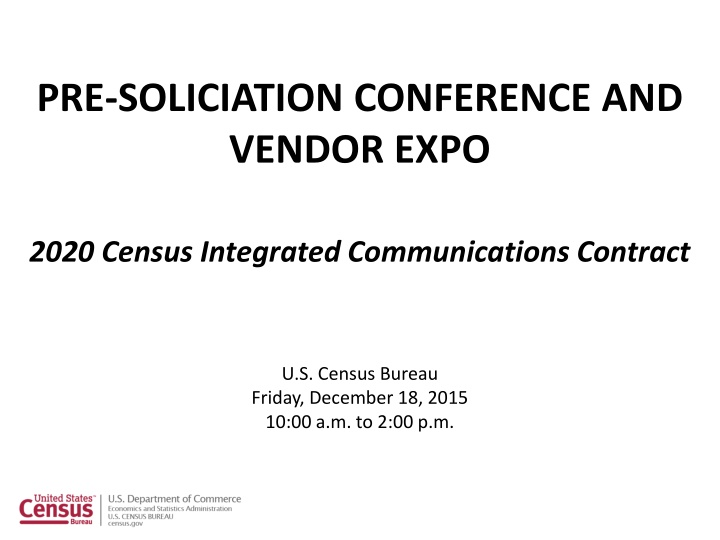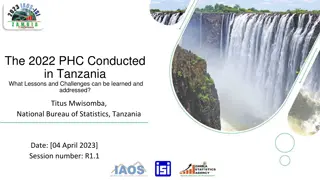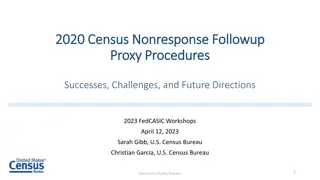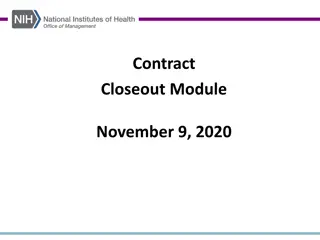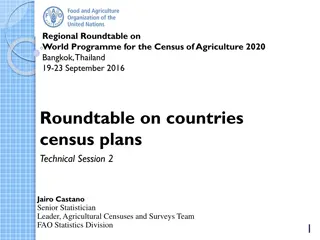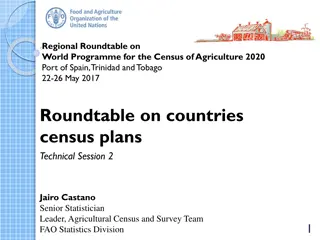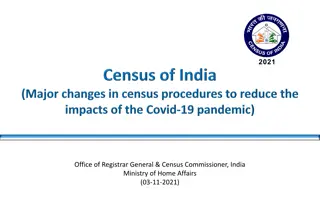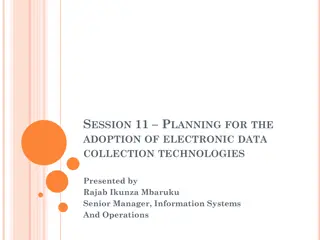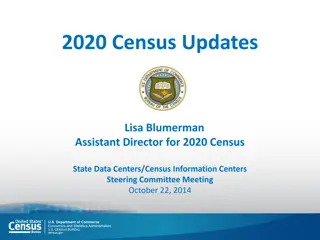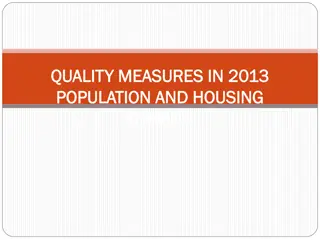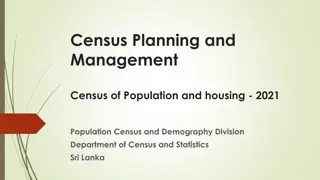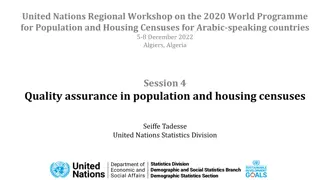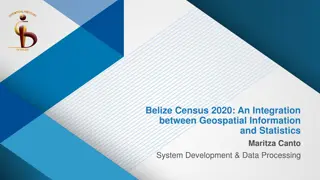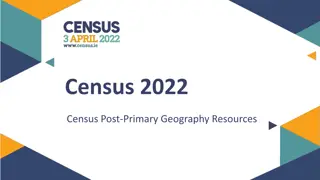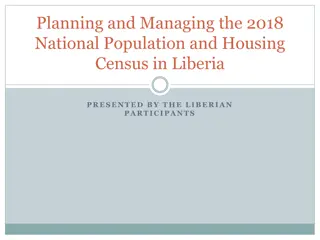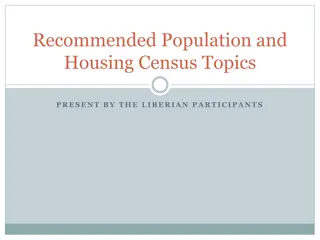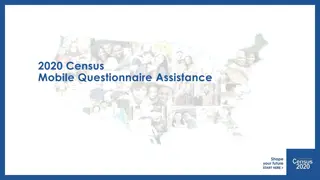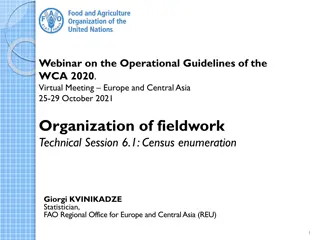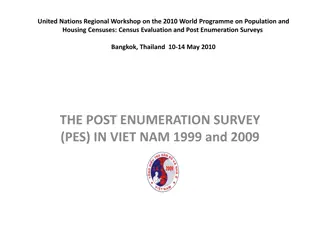2020 Census Integrated Communications Contract: Overview
The U.S. Census Bureau held a pre-solicitation conference and vendor expo for the 2020 Census Integrated Communications Contract. The event featured key speakers discussing the operational plan, purpose, and goals of the decennial census. With a focus on utilizing innovative strategies and new technologies, the 2020 Census aims to achieve a high-quality population count efficiently and effectively.
Download Presentation

Please find below an Image/Link to download the presentation.
The content on the website is provided AS IS for your information and personal use only. It may not be sold, licensed, or shared on other websites without obtaining consent from the author.If you encounter any issues during the download, it is possible that the publisher has removed the file from their server.
You are allowed to download the files provided on this website for personal or commercial use, subject to the condition that they are used lawfully. All files are the property of their respective owners.
The content on the website is provided AS IS for your information and personal use only. It may not be sold, licensed, or shared on other websites without obtaining consent from the author.
E N D
Presentation Transcript
PRE-SOLICIATION CONFERENCE AND VENDOR EXPO 2020 Census Integrated Communications Contract U.S. Census Bureau Friday, December 18, 2015 10:00 a.m. to 2:00 p.m.
WELCOME AND OPENING REMARKS Jeannie Shiffer Associate Director for Communications
2020 Census Operational Plan Lisa M. Blumerman Associate Director for Decennial Census Programs
The Decennial Census Purpose: To conduct a census of population and housing and disseminate the results to the President, the States, and the American People Primary Uses of Decennial Census Data: Apportion representation among states as mandated by Article 1, Section 2 of the United States Constitution: Representatives and direct Taxes shall be apportioned among the several States which may be included within this union, according to their respective Numbers The actual Enumeration shall be made within three Years after the first Meeting of the Congress of the United States, and within every subsequent Term of ten years, in such Manner as they shall by Law direct. Draw congressional and state legislative districts, school districts and voting precincts Enforce voting rights and civil rights legislation Distribute federal dollars to states Inform federal, tribal, state, and local government planning decisions Inform business and nonprofit organization decisions (e.g., where to locate, size of the market) Provide population benchmark for nearly every other United States survey 4
The Decennial Census The 2020 Census Environment Constrained fiscal environment Rapidly changing use of technology A mobile population The 2020 Census is being conducted in a rapidly changing environment, requiring a flexible design that takes advantages of new technologies and data sources while minimizing risk to ensure a high quality population count. Informal, complex living arrange- ments 2020 Census Information explosion Increasingly diverse population Distrust in government Declining response rates 5
The 2020 Census Goals and Key Innovation Areas Overarching Goal: To count everyone once, only once, and in the right place Challenge Goal: Conduct a 2020 Census at a lower cost per housing unit (adjusted for inflation) than the 2010 Census, while maintaining high quality results Focus on Four Key Innovation Areas Utilizing Administrative Records and Third- Party Data Reengineering Address Canvassing Optimizing Self-Response Reengineering Field Operations 6
The 2020 Census: Establish Where to Count Reengineering Address Canvassing Reduce the nationwide In-Field Address Canvassing by developing innovative methodologies for updating and maintaining the Census Bureau s address list and spatial database throughout the decade. In-Office Address Canvassing Where Should We Start? Continual Research and Updating Ongoing Process for In-Office Canvassing In-Field Address Canvassing Address List and Spatial Database 7
The 2020 Census: Motivate People to Respond Optimizing Self-Response Generate the largest possible self-response, reducing the number of households requiring follow-up. 8
The 2020 Census: Count the Population Reengineering Field Operations Use technology to more efficiently and effectively manage the 2020 Census fieldwork. Streamlined Office and Staffing Structure Increased use of Technology Increased Management and Staff Productivity Increased visibility into case status for improved workforce management Redesigned quality assurance operations Improved communications Automated and optimized work assignments Automated recruiting, training, payroll and expense reporting Ability to conduct address updates and enumeration on same device Reduced paper and manual processing Area Manager of Operations Census Field Managers Census Field Supervisors Listers and Enumerators 9
The 2020 Census: Count the Population Utilizing Administrative Records and Third-Party Data Use information people have already provided to reduce expensive in-person follow-up. Validate incoming data from federal, tribal, state, and local governments Improve the Quality of the Address List Update the address list Create the contact frame (e.g., email addresses and telephone numbers) Support the micro- targeted advertising campaign Increase Effectiveness of Advertising and Contact Strategies Validate respondent addresses for those without a Census ID and prevent fraudulent submissions Validate Respondent Submissions Remove vacant and nonresponding occupied housing units from the nonresponse followup workload Optimize the number of contact attempts Reduce Field Workload for Followup Activities 10
The 2020 Census A New Design for the 21st Century 11
Overview of the 2020 Census Integrated Partnership and Communications (IPC) Program Tasha Boone, Decennial Directorate Kendall Johnson, Communications Directorate
2020 Census The Mission Count everyone once, only once, and in the right place. 13
2020 Census Purpose of the Integrated Partnership and Communications (IPC) Program To communicate the importance of participating in the 2020 Census to the entire population of the 50 states, the District of Columbia, Puerto Rico and Island Areas: Engage and motivate people to self-respond, preferably via the Internet Raise and keep awareness high throughout the entire 2020 Census to encourage response 14
2020 Census Components of the IPC Program Partnership Establishing relationships that matter communications to build conversations Surround every household in the country with credible, memorable messages through trusted conversations that motivate people to complete the decennial census. by providing grade- appropriate classroom activities and resources in math and history that are aligned to national standards and complement existing lesson plans. Social Media Leveraging interactive Creating a chorus of Census conversations literacy education and outreach to students in Kindergarten, middle school, and high school, including tribal schools, home schools, and Head Start. with to inform, educate and inspire to respond. source. Public Relations Statistics in Schools Providing ongoing statistical Leveraging all relevant communication channels to create mass participation drive mass participation Advertising Earned Media Creating widespread awareness and education to Social Media Partnership Connecting with trusted organizations to carry the decennial message through a vast network across the country. Supports statistics education Creating a 24/7 movement through real-time access, education and inspiration. through an identifiable Reaching audiences through mediums they are familiar network to reach people Using the vast media Earned Media Statistics in Schools Advertising 15
2010 Census Audience Segmentation 2010 Census Program for Evaluations and Experiments (CPEX) This page contains the evaluations, experiments, and assessments from the 2010 Census. http://www.census.gov/2010census/about/cpex.php 2015 Planning Database This page contains the 2015 Planning Database. The planning database assembles a range of housing, demographic, socio-economic, and census operational data that can be used for survey and census planning. http://www.census.gov/research/data/planning_database/2015/ 16
2010 Census Language Program Approved audience/language list for the paid media effort increased by 14 languages to a total of 28 Original Funding English Spanish Mandarin Cantonese Vietnamese Korean Tagalog/Taglish Russian Polish Arabic French Creole Japanese Hindi/Hinglish Khmer (Cambodia) American Recovery Reinvestment Act (ARRA) Portuguese French Italian German Yiddish Farsi Armenian Ukranian Greek Hmong Laotian Thai Urdu (Pakistan) Bengali 17
2010 Census Advertising Campaign Census 2000 2010 Census Local Buys (Mostly directed to HTC population) 34% Local Buys (Mostly directed to HTC population) 48% National Buys (All audiences) 66% National Buys (All audiences) 52% National Buys includes media purchased as part of any audience plan, including Diverse Mass, Black, Hispanic, etc. 18 18
2010 Census Campaign Phases JANUARY MARCH/APRIL MAY/JUNE FEBRUARY Awareness Support Motivation Education 19
2010 Census Top Lessons Learned Integrate Census Bureau subject matter experts into all phases of the 2020 Census Integrated Partnership and Communications Program Align timing, funding, and design decisions between the development of the Integrated Partnership and Communications Program Plan and the Census Bureau s operational milestones to effectively support all phases of the 2020 Census Establish more specific program metrics for the Integrated Partnership and Communications Program to assist in evaluation and assessment Incorporate ever-advancing technology into the ICC planning process to ensure optimal communication and that Census response systems are used. 20
2010 Census Top Lessons Learned (Continued) The success of the ICC was in part due to getting real-time market data for the first time and being able to analyze it, then making in-market adjustments. Engage stakeholders early and often. Improve the understanding and transparency of the media buying process among key stakeholders and the Paid Media community. An earlier start allows for the development and validation of a brand identity that can be used across all programs and channels to ensure a cohesive look and feel. 21
2010 Census Evaluation of the Campaign Overview and Purpose NORC at the University of Chicago was selected to conduct the evaluation Upon completion of the evaluation, their final report was to identify whether the ICP achieved its goals: Increase mail response rate Improve overall accuracy and reduce the differential undercount Improve cooperation with enumerators Findings/Challenges It was difficult to evaluate the campaign. NORC did not have all the data they needed to evaluate the components effectively, as data collection began after the program started. 2020 Recommendations Involve independent evaluation contractor earlier in the campaign The independent evaluation contractor and the 2020 ICC contractor need to develop metrics together to approximately measure and evaluate the campaign 22
2015 Census Test: Optimizing Self-Response Communications Research Goals: Test insights will support these 2020 Census goals: Increase opportunities to engage hard-to-count populations. 1. Increased self-response to reduce NRFU and related costs. 2. Tested communication activities to inform the 2020 communication program. Objectives: Implement a comprehensive and integrated communications program in the Savannah media market. 1. Motivated self-response, especially online. 2. Answered communications research questions regarding the use and impact of micro-targeted digital advertising. 23
2015 Census Test: Optimizing Self Response Communications Research (Continued) What were the effects of integrating and combining digital advertising and micro- targeted ads with other traditional communications, such as mail postcards and letters, earned media coverage, computer-automated phone calls, broadcast and radio ads, and outreach through partnerships? Specifically, we explored the effects on: Internet and overall self-response rates Internet and self-response rates of housing units targeted by specific mail-out strategies Socio-demographic characteristics of internet responders 24
2015 Census Test: Optimizing Self-Response Paid Advertising Types of Digital Micro-Targeted Advertising Demographic: age, sex, race, device type used Example: Focused on 65+ in Beaufort County, SC Behavioral: past online behavior and/or lifestyle data Example: Focused on those in select ZIP codes in Chatham County, GA, who have visited Spanish language websites in the past Geographic: location (ZIP code, block group) Contextual: content with which users are currently engaging 25
2015 Census Test: Optimizing Self-Response Landscape Test focused on Savannah designated market area (DMA) 20 counties (17 in Georgia and 3 in South Carolina) 106 ZIP codes Attempted to replicate key census communications elements Earned media Partnership and outreach Television and radio advertising Print and out-of-home advertising Digital advertising and social media Influencer phone calls (60,000 calls) Mailings to sample of households (120,000 HHs) No Non-Response Follow Up (NRFU) 26
The 2020 Census The 2020 Census Key Upcoming Activities 2016 Address Canvassing Test 2016 Census Test (April 1st Census Day) Anticipated Award of Contract for the 2020 Census Questionnaire Assistance (CQA) Anticipated Award of Integrated Communications Contract 2016 2017 Census Test (April 1st Census Day) Topics to Congress by March 31, 2017 Local Update of Census Addresses Invitations sent to governmental entities to participate in review of our Master Address File and is complete in 2018 2017 2018 End-to-End Test (April 1st Census Day) Question Wording to Congress by March 31, 2018. 2018 2020 Census Day April 1, 2020 Nonresponse Follow-up Begins in late April and continues until late June/early July Apportionment Counts to the President by December 31, 2020 2021 Redistricting Counts to the States by March 31, 2021 27
REQUEST FOR PROPOSAL (RFP) DISCUSSION Cory Harris, Acquisition Division Benjamin Banyasz, Acquisition Division
2020 Census Request for Proposal (RFP) What Are We Looking For? The Census Bureau is looking to award a contract to plan, design, integrate, produce, implement, and assess an integrated communications program in support of the U.S. Census Bureau s 2020 Decennial Census. 29
2020 Census Request for Proposal (RFP) Contract Overview Full and open competition One single award Indefinite Delivery Indefinite Quantity (IDIQ) contract Task Order Types: Firm Fixed Price (FFP), Time and Material (T&M), or a hybrid of both FFP and T&M Period of Performance: One (1) base year and five (5) option years Aggressive subcontracting goals with plenty of opportunity for small businesses 30
2020 Census Request for Proposal (RFP) RFP Format RFP format is divided by sections: A Solicitation, Offer and Award (SF 33) B Supplies or Services and Prices/Cost C Description/Specifications/Statement of Work D Packaging and Marking E Inspection and Acceptance F Deliveries or Performance G Contract Administration Data H Special Contract Requirements I Contract Clauses J Attachments K Representations, Certifications and Other Statements of Offerors L Instructions, Conditions and Notices to Offerors M Evaluation Factors for Award 31
2020 Census Request for Proposal (RFP) Section C: Description/Specifications/Statement of Work Background information about the decennial census; experience from previous censuses; operational planning for the 2020 Census; and goals for the 2020 Census Information regarding measuring contractor s performance, small business subcontracting, and the Participation Plan Performance-based statement of work description of required services 32
2020 Census Request for Proposal (RFP) Section C: Performance Work Statement Services may include, but are not limited to: Research and Data Analytics Strategic Planning, Program Development, and Integration Communications Support for Decennial Census Operations and Other Programs Field Recruitment Advertising and Communications Traditional Advertising and Media Buying Digital Advertising and Other Communications Technologies Social Media Public Relations Communications Planning and Materials for the Partnership Program Statistics in Schools Program Website Development and Digital Engagement Rapid Response Activities Project and Financial Management Stakeholders Relations Communications Support for the 2020 Census Data Dissemination 33
2020 Census Request for Proposal (RFP) Section L: Instructions, Conditions, and Notices to Offerors Provides guidelines on the acquisition process, how proposals shall be submitted, and what shall be included in the proposal to be evaluated under Section M Evaluation Factors for Award. 34
2020 Census Request for Proposal (RFP) Section M: Evaluation Factors for Award (Continued) Provides the manner in which the Census Bureau will evaluate the information provided in response to Section L Instructions, Conditions and Notices to Offerors. 35
2020 Census Request for Proposal (RFP) Section M: Evaluation Factors for Award Technical Evaluation Factors (in descending order of importance): Factor 1 Technical Approach, Management Approach, and Designated Market Area (DMA) Exercise Subfactor 1A Technical Approach Subfactor 1B Management Approach Subfactor 1C DMA Exercise Factor 2 Participation Plan and Small Business Subcontracting Approach Subfactor 2A Participation Plan Subfactor 2B Small Business Subcontracting Approach Factor 3 Similar Experience, Key Personnel, and Past Performance Subfactor 3A Similar Experience Subfactor 3B Key Personnel Subfactor 3C Past Performance 36
2020 Census Request for Proposal (RFP) Section M: Evaluation Factors for Award (Continued) Price Evaluation Factor: Factor 4 Price Price comparison will be conducted based on the firm fixed price (FFP) for overall project management for the entire lifecycle of the contract and the FFP for the DMA Exercise. Other price information required (fees, other cost provisions* and labor rates) will be used to assess accuracy and completeness, realism, reasonableness, and risk. * Includes subcontracting fees, fringe benefits, G&A, overhead, and profit 37
2020 Census Request for Proposal (RFP) Tentative Milestone Schedule Date(s)* Activity December 28, 2015 Vendors submit questions to the Census Bureau on the draft RFP January 8, 2016 January 19, 2016 Census Bureau issues written responses to questions on the draft RFP Census Bureau issues final RFP January 22, 2016 Vendors submit questions to the Census Bureau on the final RFP January 27, 2016 Census Bureau issues written responses to questions on the final RFP February 18, 2016 Offerors submit written proposals to the Census Bureau March 25, 2016 Census Bureau announces competitive range determination Census Bureau conducts oral presentations and discussions with vendors in the competitive range April 11 to May 5, 2016 May 20, 2016 Offerors submit final proposal revisions to the Census Bureau May 23 to July 15, 2016 Census Bureau conducts final evaluation and consensus August 17, 2016 Census Bureau makes source selection (award) announcement *Dates are subject to change 38
SMALL BUSINESS PARTICIPATION Dijon Ferdinand, Acquisition Division Small Business Representative for U.S. Census Bureau
2020 Census Small Business Participation Market Research Request for Information (RFI) released on FedBizOpps on October 1, 2014. Received 32 responses from small (19) and large (13) businesses. Census Bureau held market research meetings with small and large companies . 40
2020 Census Small Business Participation Market Research Continued What the Census Bureau has learned from industry: Sources There exists adequate and abundant sources in the private sector to satisfy Government requirements. Contract Type Indefinite Delivery Indefinite Quantity (IDIQ) contract is the most favored type of contract, with Firm Fixed Price (FFP) and Time and Materials (T&M) task orders. Cost reimbursement tasks are not favored. Types of Companies All types of companies are interested in serving as the prime including management consulting, research and data analytics, public relations, as well as full-service communications companies (not just advertising companies.) Incentives Monetary incentives are not the most important type of incentive that would motivate a contractor; companies are more interested in good past performance ratings. Small Businesses Small businesses play an important role in the contract due to the myriad of services they provide. However, the size, scope and complexity of this contract would put a burden on and financially jeopardize small firms if they acted as the prime. 41
2020 Census Small Business Participation Subcontracting Goals It is the Census Bureau s goal to assist the Department of Commerce in meeting or exceeding the statutory goals for small businesses. With that said, the Census Bureau is interested in pursuing aggressive small business subcontracting under this contract. The Census Bureau is encouraging contractors to achieve small business subcontracting goals to the maximum extent possible. In Section C.7, the FY 2015 Department of Commerce Operating Unit Small Business Subcontracting Goals are provided for your information. FY 2015 Department of Commerce Operating Unit Small Business Subcontracting Goals: Small Business Small Disadvantaged Business 8(a) Business Woman-Owned Small Business HUBZone Small Business Veteran-Owned Small Business Service-Disabled Veteran-Owned Small Business 49% 12% 6% 10% 3% 4% 3% For this contract, the Contractor shall establish, maintain, and adhere to a Small Business Subcontracting Plan that commits the maximum practicable opportunity for small businesses within the contract. 42
2020 Census Small Business Participation Networking Opportunities There will be a Vendors Expo held directly after this Pre-Solicitation Conference for networking opportunities for small and large businesses. Please take advantage of this time to exchange ideas, network with other companies, and present capabilities and/or experiences to each other. Furthermore, the agency hopes the event will promote teaming arrangements for this procurement and upcoming opportunities. 43
2020 Census Small Business Participation Contact Information Acquisition Division s E-Mail (for this solicitation): acq.2020.comm@census.gov Acquisition Division s Website (for this solicitation): http://www.census.gov/about/business-opportunities/opportunities/vender- opps/2014-10-15-2020-comm.html U.S. Census Bureau Small Business: Dijon (DJ) Ferdinand 301-763-1822 Department of Commerce, Office of Small and Disadvantaged Business Utilization: LaJuene Desmukes 202-482-8102 44
QUESTIONS AND ANSWERS (Q&A) Kendall Johnson Communications Directorate
QUESTIONS ON THE DRAFT RFP Send questions on the Draft RFP to: acq.2020.comm@census.gov No later than 3:00 p.m. EST on Monday, December 28, 2015
CLOSING REMARKS Thank you for your participation in the conference and vendor expo. Kendall Johnson Communications Directorate
